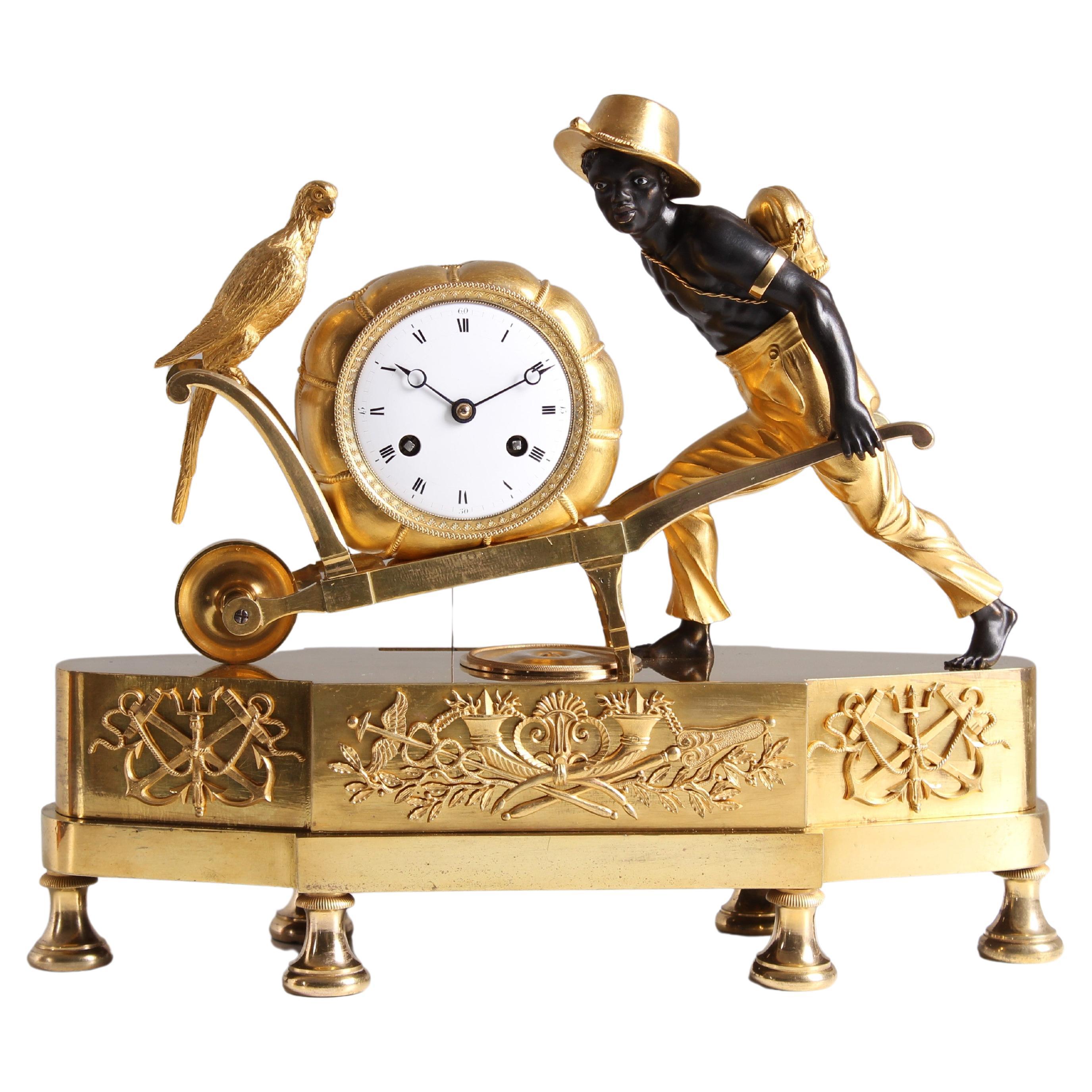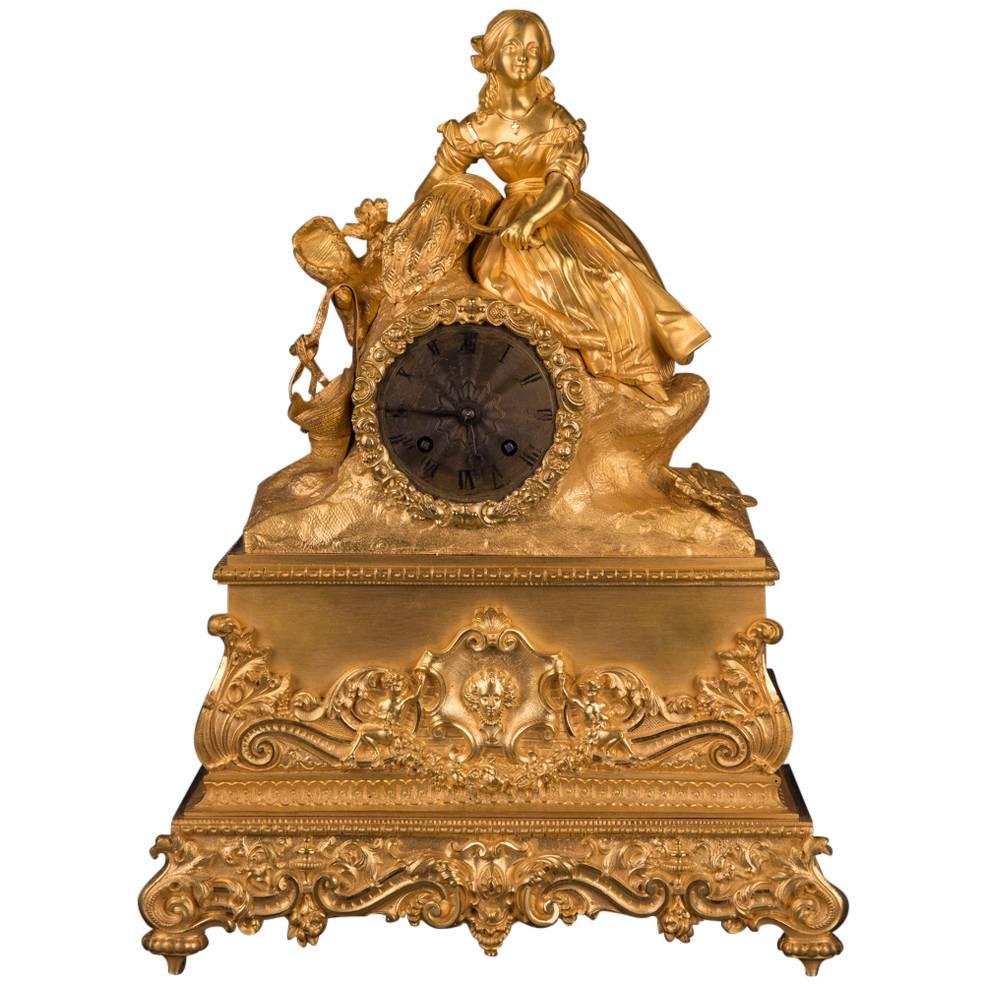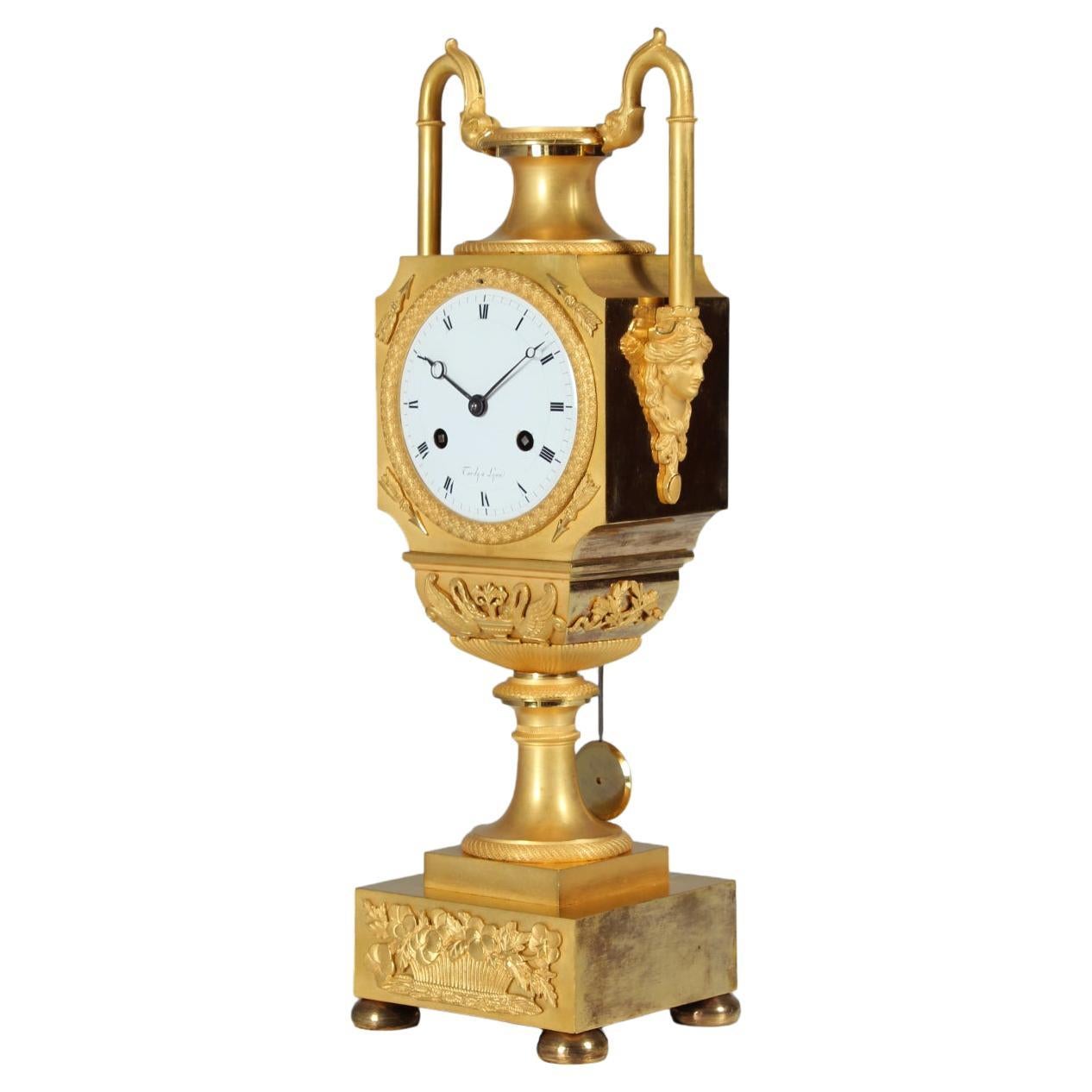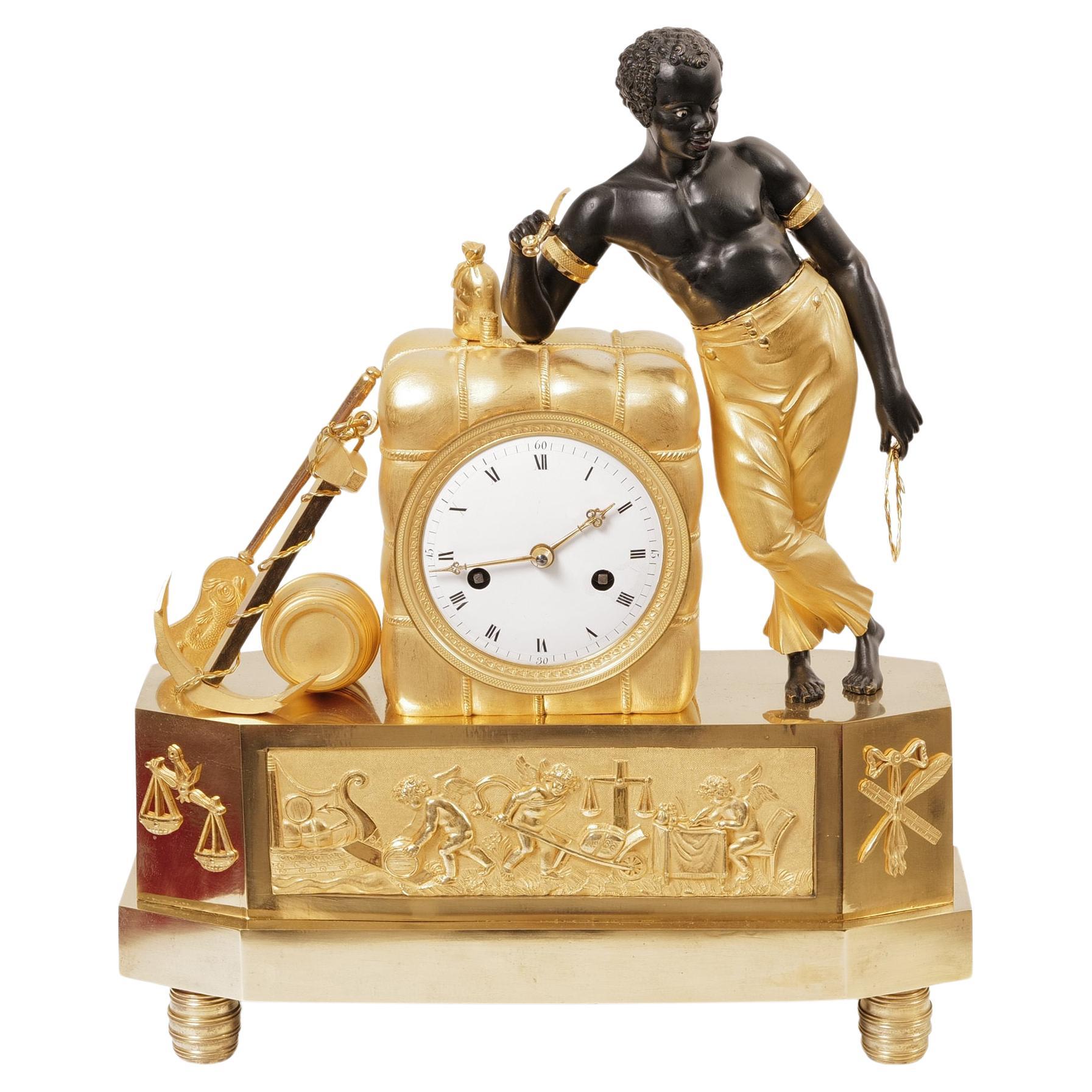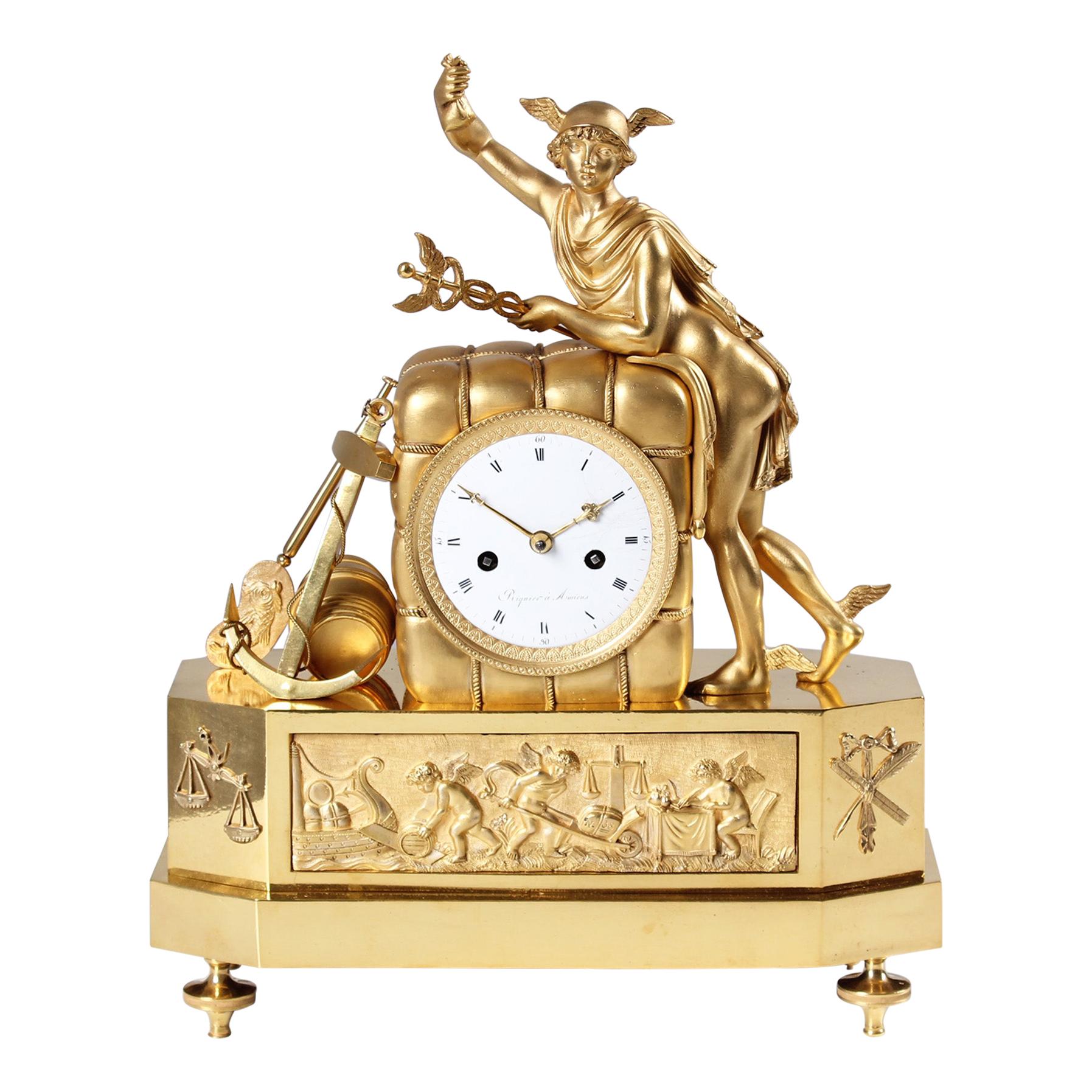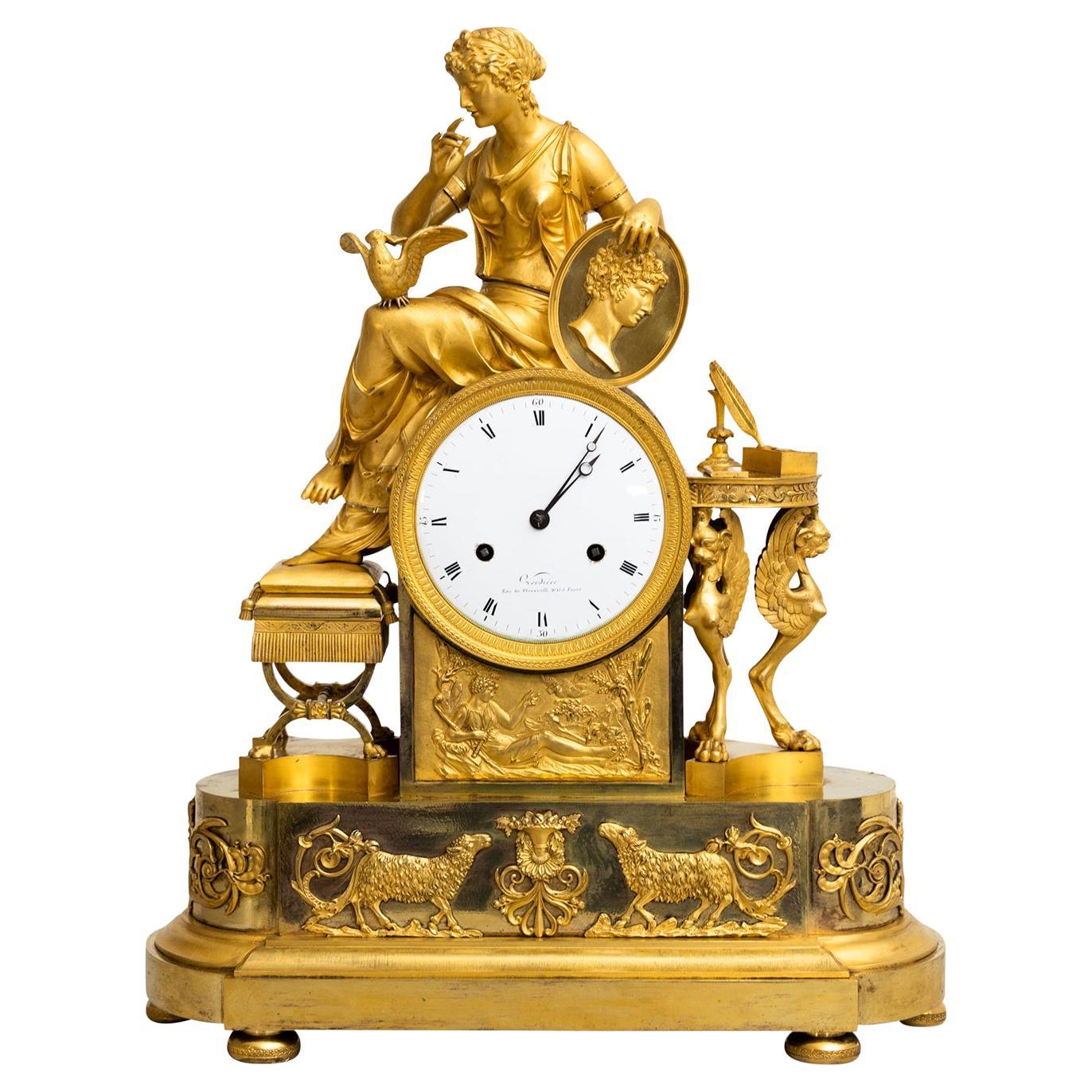Items Similar to Early 19th Century Pendule Portefaix, Firegilt Bronze, Empire, Circa 1810
Video Loading
Want more images or videos?
Request additional images or videos from the seller
1 of 17
Early 19th Century Pendule Portefaix, Firegilt Bronze, Empire, Circa 1810
About the Item
Pendule Portefaix
France (Toulouse)
bronze, enamel
Empire around 1810
Dimensions: H x W x D: 36 x 28 x 11 cm
Description:
Beautiful fire-gilded and patinated bronze pendulum from the early 19th century. Depicted is a young man carrying a large cotton package on his back. In his right hand he holds a letter, with his left he is leaning on a bamboo stick. His tobacco pipe is stuck in his hat string, and he carries his water bottle on his belt.
In interesting color contrast is not only the fire gilding to the deep black patinated bronze, but also particularly striking are the white glass eyes.
The ciselleur has managed to make materials tangible through different surface treatments. For example, the skin is discreetly hatched differently from the cotton fabric of the trousers; the bottle, bracelets and pannier are polished in gold. The proportions of the figure are perfectly struck, and the drapery on the trousers emphasizes the dynamic movement.
The heart of the watch is an 8-day movement with date from the Prevost Freres workshop, which is attested in Toulouse from 1809.
The Breguet hands are blued, the pendulum is suspended on a thread, typical of the time. The clock strikes a bell on the half and full hour.
Fun Facts:
The depiction of Le Portefaix is by Parisian bronze caster Jean-André Reiche, who registered his artistic design in Paris in 1808. In addition to the depiction of the cotton picker, there are numerous other pendulums that deal with the theme of colonization. Other themes from the "new world" were also treated artistically - exotic animals and plants - butterflies, birds of paradise, tobacco and spices....
Today's viewers react to the objects with both fascination and irritation. Enthusiastic on the one hand by the obvious quality of the detailed bronzes, on the other hand distanced-cautious because of the possible discrimination that is suspected behind it. The ambivalence of this feeling motivates the search for the conditions of origin of these pendulums.
Europeans found their new ideal of the natural man mainly in fictional and realistic travelogues about the Indians of North America, the black Africans and the South Sea Islanders. Some of these works are still considered world literature today; think of Jonathan Swift's "Gulliver's Travels" (1726) or Daniel Defoe's "Robinson Crusoe" (1719).
As a sign of admiration for the exotic, the "Au bon Sauvage" pendulums are a typical feature of the Enlightenment at the end of the 18th century. They show the longings of a hitherto Europe-centered society, which was urged to look beyond its usual horizon, especially by the discovery of seafaring and by the revolution of 1789.
[Source: Elke Niehüser - The French Bronze Clock pp. 140-143]
Specimens of this clock are in the world's great museums, such as the Musée des Arts Décoratifs in Paris.
Condition:
Beautiful preservation of fire gilding with rubbing to the base and pommel.
Cleaned from scratch and perfectly working movement.
This clock is illustrated in several reference books, including:
Giacomo et Aurélie Wannenes - Les plus belles pendules francaises p. 312
Elke Niehüser - French Bronze Clocks fig. 240
The Prevost Freres workshop is documented in the following literature:
Brian Loomes - Watchmakers and Clockmakers of the World p. 628
- Dimensions:Height: 14.18 in (36 cm)Width: 11.03 in (28 cm)Depth: 4.34 in (11 cm)
- Style:Empire (Of the Period)
- Materials and Techniques:
- Place of Origin:
- Period:
- Date of Manufacture:1809
- Condition:Wear consistent with age and use. Beautiful preservation of fire gilding with rubbing to the base and pommel. Cleaned and perfectly working movement.
- Seller Location:Greven, DE
- Reference Number:1stDibs: LU5419235442152
About the Seller
5.0
Platinum Seller
These expertly vetted sellers are 1stDibs' most experienced sellers and are rated highest by our customers.
Established in 2014
1stDibs seller since 2020
114 sales on 1stDibs
Typical response time: <1 hour
- ShippingRetrieving quote...Ships From: Münster, Germany
- Return PolicyA return for this item may be initiated within 14 days of delivery.
More From This SellerView All
- Early 19th Century Mantel Clock, Firegilt Bronze, Paris circa 1810Located in Greven, DEVery rare "Au Bon Sauvage" mantel clock France Fire-gilt and patinated bronze Empire around 1810 Dimensions: H x W x D: 34 x 41 x 13 cm Description: Extremely rare French bronze m...Category
Antique Early 19th Century French Empire Mantel Clocks
MaterialsBronze
- Early 19th Century Vase Pendule, Pendulum-Clock, Tardy à Lyon, Empire circa 1820Located in Greven, DEAntique vase clock France Fire gilded bronze Empire around 1820 Dimensions: H x W x D: 41 x 13 x 12 Description: Beautiful all gilt French mantel clock. The basic form is in the shape of an urn vase with lid...Category
Antique Early 19th Century French Empire Mantel Clocks
MaterialsBronze, Enamel
- 19th French Empire Mantel Clock, Pendule, Mercury, Gilded Bronze, circa 1815Located in Greven, DE19th century French pendule, mantel clock - Mercury the messenger of the gods France Bronze gilded Empire around 1815 Dimensions: H x W x D: 37 x 30 x 10 cm Description: French Empire...Category
Antique Early 19th Century French Empire Mantel Clocks
MaterialsBronze
- Early 19th Century Ormolu Mantel Clock, Atala freeing Chactas, Paris, circa 1810Located in Greven, DEMantel Clock "Atala and Chactas" Paris Bronze (fire-gilt and patinated), enamel Empire around 1810 Dimensions: H x W x D: 40 x 32 x 11 cm Description: Very rare and extremely high quality French mantel clock, so-called Pendule Au Bon Sauvage. Depicted are scenes from the love story "Atala or the love of two savages in the desert" written by Francois René Vicomte de Chateaubriand in 1801. At the beginning of the 19th century, this was probably the most famous love story in Europe, but today it has been forgotten. The story, set in present-day Louisiana (USA), is roughly rewritten about the forbidden love between Chactas, a young Indian, and Atala, the beautiful daughter of a Spaniard. Chactas is captured in a battle between two Indian tribes, chained to a palm tree and is to be sacrificed. Atala wants to save his life and convert him to Christianity. She unties him from the palm tree at night and they flee together into the wilderness of North America. Their love for each other grows stronger and stronger and they have prospects for a future together. The story takes a tragic turn when Atala, who must remain a virgin due to a vow made by her mother, can no longer withstand the conflict of her feelings and commits suicide. The main group of characters thus shows Chacta's liberation through Atala. Atala is leaning against a pile of logs. The animal fur thrown over the logs and the weapons leaning against the stack on the right give the impression of a night camp. The bronze is of rarely beautiful quality, finely chiselled and makes the scene appear very lively. The contrast of fire-gilded and patinated bronze adds tension to the composition. In the base we see the Entombment as the end of the tragic love story. This bronze work is also very detailed, the interplay of bright and matt gilding makes the flat relief appear much deeper than it is. The depiction of the mantel clock presented here shows that the exotic was only known from stories and that the bronzier had his own ideas about the appearance of this distant world. The Indian, for example, has very European facial features and his skin was not black in reality, of course. The palm tree was also certainly not found in the North American wilderness. The heart of the clock is a French pendulum movement, integrated into the wooden pile, with an eight-day power reserve and a lock plate striking a bell on the half and full hour. The pendulum is suspended on a thread, typical of the period. The classically shaped hands, so-called Breguet hands, are also typical of the time. The enamelled dial has black Roman hour numerals, Arabic quarter hours and bears the signature: Le Roy hr. de Madame A PARIS. Interesting facts: The period from 1795 to about 1815 saw the creation of probably the most spectacular group of bronzes: The "Au bon Sauvage" pendulums - depictions of the "Noble Savage". Today's viewers react to these objects with both fascination and irritation. Enthusiastic on the one hand about the obvious quality of the detailed bronzes and the allure of the exotic, on the other hand distanced and cautious because of the possible discrimination that is suspected behind them. The ambivalence of this feeling motivates the search for the conditions of origin of these pendulums. Europeans found their new ideal of the natural man primarily in fictional and realistic travelogues about the Indians of North America...Category
Antique Early 19th Century French Empire Mantel Clocks
MaterialsOrmolu
- 19th Century Travel Clock with Repetition, Carriage Clock, Pendule de VoyageLocated in Greven, DETravel clock with repetition France Brass 19th century Dimensions: H x W x D: 11 x 7,5 x 4,5 cm Description: Small travel clock, so-call...Category
Antique 19th Century French Carriage Clocks and Travel Clocks
MaterialsBrass
- French Directoire Pendule, Black Marble, Firegilded Bronze, circa 1800Located in Greven, DEAntique portal clock France marble, bronze, enamel Directoire around 1800 Dimensions: H x W x D: 46 x 28 x 14 cm Description: Antique portal c...Category
Antique Early 19th Century French Directoire Mantel Clocks
MaterialsBelgian Black Marble, Bronze
You May Also Like
- 19th Century Empire Bronze Fire-Gilded PenduleLocated in Berlin, DEGreat bronze pendulum. Base and pedestal with lavish floral and figurative embellishments such as rocaille, acanthus leaves, cartouches, garlands, putti and central masks. Additional...Category
Antique 19th Century French Empire Table Clocks and Desk Clocks
MaterialsBronze
- Early 19th Century French Empire Pendule "au bon sauvage" MatelotLocated in Münster, DEPendule "au bon sauvage" Matelot Paris, Empire circa 1810, bronze, fire-gilded and patinated, enamel Eight-day movement with lock disc and thread suspension, strike on bell on the ...Category
Antique 1810s French Empire Mantel Clocks
MaterialsBronze
- 19th Century Gold French Empire Gilded Bronze Table Clock, Antique PenduleLocated in West Palm Beach, FLA gold, antique French table clock, pendulum made of hand crafted fire-gilded bronze, in good condition. The circular enamel dial of the Pa...Category
Antique Early 19th Century French Empire Mantel Clocks
MaterialsMetal, Bronze
- Elegant 19th Century Bronze Clock EmpireBy Europa AntiquesLocated in Madrid, ESElegant 19th century bronze clock. 19th Century French clock in gilded bronze. The machinery works and has its pendulum and key. Difficult ...Category
Antique 19th Century French Empire Table Clocks and Desk Clocks
MaterialsBronze
- Early 19th Century French Empire Period Gilt Bronze Figural ClockLocated in Hamilton, OntarioEarly 19th century French Empire period gilt bronze figural clock. Free shipping within the United States and Canada.Category
Antique Early 19th Century French Empire Mantel Clocks
- Empire Portal Clock, France, Early 19th CenturyLocated in Greding, DEPortal clock on a rectangular, stepped base in mahogany veneered with small bun feet. The stepped architrave is supported by four smooth columns, the capi...Category
Antique Early 19th Century French Empire Mantel Clocks
MaterialsBronze
Recently Viewed
View AllMore Ways To Browse
Christofle Clock
Antique French Clocks With Ball
Elliott Bracket Clock
Modern Pendule Clock
Mystery Elephant Clock
Glass Dome For Clock
Edward F Caldwell Clock
Hundertwasser Watches
Charpentier Ft Bronze Paris
Louis Xv Mantel Clock Value
Pendule Cartier
Table Octogonale
Asteria Clock
Drum Head Long Case Clock
Jaeger Lecoultre Mystery Clock
Newgate Clock
Sunburst Clock With Sconces
Vintage Solar Mantle Clock
